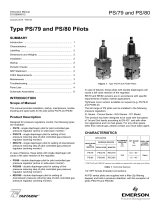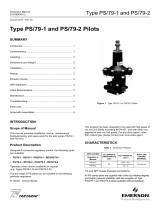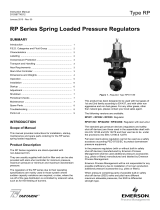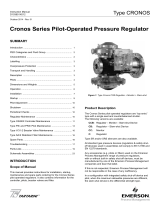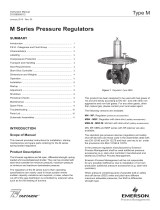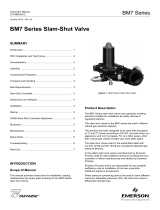Page is loading ...

Instruction Manual
D103805X012
January 2019
Type V/31-2
SUMMARY
Introduction ......................................................................... 1
Characteristics .................................................................... 1
Labelling ............................................................................. 2
Dimensions and Weight ...................................................... 2
Installation .......................................................................... 3
Startup ................................................................................ 3
SEP Statement .................................................................. 3
Field Inspection and Maintenance ...................................... 3
Troubleshooting .................................................................. 4
Parts Lists ........................................................................... 4
Schematic Assemblies........................................................ 5
INTRODUCTION
Scope of Manual
This manual provides installation, startup, maintenance,
troubleshooting, and spare parts for the booster valve
Type V/31-2.
Product Description
In monitor-regulator systems the booster valve V/31-2 is
installed on the motorization pressure circuit, in order to
obtain a more rapid action in monitor closing.
This product has been designed to be used with fuel gases of
1st and 2nd family according to EN 437, and with other non
aggressive and non fuel gases. For any other gases, other
than natural gas, please contact your local sales agent.
Tightness cover version V/31-2-D available on request.
The booster valve Type V/31-2 can be installed in the
following pressure regulators:
• FL Series
• Cronos Series
CHARACTERISTICS
Table 1. Technical Features
MODEL
ALLOWABLE
PRESSURE PS
(bar)
SET RANGE W
d
(bar)
BODY AND
COVERS
MATERIAL
V/31-2 19 0.015 - 0.55 Aluminum
1/4-inch NPT female threaded connections.
Type V/31-2 Booster Valve
Figure 1. Type V/31-2 Booster Valve

2
Type V/31-2
LABELLING
APPARECCHIO TIPO/DEVICE TYPE
Wau
DN2
DN1
MATRICOLA
bar
bar
SERIAL Nr.
°C
FLUIDO GRUPPO
FLUID GROUP
ANNO
YEAR
HARMONIZED STD.
bar
NORME ARMONIZ.
LEAKAGE CLASS
CLASSE DI PERDITA
FUNCTIONAL CLASS
CLASSE FUNZIONALE
bar
Wao
Wa
TS
bar
pao
Cg
PS
body
bar PT= xPS bar
PS
covers
EN
bar
pmax
xxxx
body
Notified
BOLOGNA ITALY
O.M.T.
1.5Note 4Note 3
Note2
Note 1
1
-
Figure 2. Label for V/31-2 Booster Valve
Note 1: See “Characteristics”
Note 2: Year of Manufacture
Note 3: Class 1: -10° to 60°C
Class 2: -20° to 60°C
Note 4: See “Characteristics”
Figure 3. Dimensions (mm) Type V/31-2 Booster Valve
TYPE V/31-2 WEIGHT: 2.5 kg
DIMENSIONS AND WEIGHT
280
180
Ø 144

3
Type V/31-2
CAUTION
The management of surveillance activities
should be carried out by qualied, skilled
personnel only.
For further information, please contact our
Technical Support Representatives or our
authorized dealers.
INSTALLATION
a. Check that data on the pilot’s plate are compatible with
actual working conditions.
b. Install in accordance with regulator instruction manual.
STARTUP
See the set-up and pilot adjustment instructions applying to
the equipment where the booster valve is tted.
SEP STATEMENT
Emerson declares this product conforms to Pressure
Equipment Directive PED 2014/68/UE.
Article 4 section 3 and was designed and manufactured in
accordance with sound engineering practice (SEP).
Per Article 4 section 3, this “SEP” product must not bear the
CE marking.
FIELD INSPECTION AND MAINTENANCE
The valve parts are subject to normal wear and must be
inspected periodically and replaced if necessary.
The frequency of inspection/checks and replacement
depends upon the severity of service conditions and
according to applicable National or Industry codes,
standards and regulations/recommendations.
In accordance with applicable National or Industry codes,
standards and regulations/recommendations, all hazards
covered by specic tests after nal assembling before apply-
ing the CE marking, shall be covered also after every subse-
quent reassembly at installation site, in order to ensure that
the equipment will be functional throughout its intended life.
Before proceeding with any maintenance work, shutoff the
gas upstream and downstream from the regulator, also
ensure that there is no gas pressure inside the body by
loosening the upstream and downstream connections.
Upon completion, check for leaks using an appropriate leak
detection solution.
Replacing Seal Pad
a. Disconnect all ttings, remove valve from the line and
unscrew nuts (key 13) then remove cover (key 4), spring
holder (key 5) and spring (key 6).
b.
Hold stem (key 19) using a wrench inserted into the notch.
c. Unscrew seat (key 16).
d. Using a tube wrench disassemble pad holder (key 18)
and replace pad (key 17).
General Maintenance
a. Disconnect all ttings, remove valve from the line and
unscrew nuts (key 13) then remove cover (key 4), spring
holder (key 5) and spring (key 6).
b. Replace gasket (key 26).
c. Hold stem (key 19) using a wrench inserted into the notch
and unscrew nut (key 7).
d. Disassemble parts and replace diaphragm (key 10) and
O-ring (key 22).
e. Unscrew seat (key 16) and replace O-ring (key 15).
f. Using a tube wrench disassemble pad holder (key 18)
and replace pad (key 17).
g. Remove stem unit (key 19), unscrew stem guide (key 20),
replace O-ring (key 15) and lip seals (key 21).
Reassembly
Lubricate static O-rings and lip seals with a grease thin layer,
be very careful not to damage it when reassembling.
No other valve parts are to be lubricated. Reassemble parts
by reversing the above steps.
As you proceed, make sure that parts move freely and with-
out friction.
CAUTION
Keep particular attention to the tightening
of the nut (key 7) to not cause stress on the
diaphragm (key 10).
Also, be careful to the insertion of stem
(key 19) into stem guide (key 20) so as not to
pinch lip seal (key 21).

4
Type V/31-2
PARTS LIST
Type V/31-2 Booster Valve
(See Figure 4)
Item Description
1 Adjusting screw
2 Nut
3 Cap
4 Cover
5 Spring holder
6 Spring
7 Nut
8 Washer
9 Plate
10* Diaphragm
11 Screw
12 Washer
13 Nut
14 Fitting
15* O-ring
16 Seat
17* Pad
18 Pad holder
Table 2. Troubleshooting for Type V/31-2 Booster Valve
SYMPTOMS CAUSE ACTIONS
Desired setpoint is not reached
Calibration spring (key 6) is too weak
Check the springs catalogue and replace it
with a stronger one
Lack of gas from valve connections Check valve connections
Slow monitor response Pad (key 17) is swollen preventing proper relief ow Replace pad
The booster valve does not work Valve diaphragm is broken (Key 10) Replace diaphragm
Gas continually escaping from relief (B) Defective seal of pad (key 17) Check and eventually replace pad
TROUBLESHOOTING
Item Description
19 Stem
20 Stem guide
21* Lip seal
22* O-ring
23 Plate
24 Body
25 Screw
26* Gasket
27 Label
28* O-ring
29* O-ring
30 Elastic ring
31 Fitting
Rubber parts marked with (*) are supplied in the “spare parts
kit”, recommended as stock.
To order the kit it is necessary to communicate to us the
valve serial number.

5
Type V/31-2
19
18
22
21
1
2
3
4
5
6
7
8 9 10 11
12
13
14
16
15
14
15
23
2414
20
17
C
B
A
2625
27
Figure 4.Type V/31-2 Booster Valve
ITEM CONNECTIONS
A
Loading Pressure
B Downstream or safe area
C Downstream of the regulator
SCHEMATIC ASSEMBLIES
Table 3. V/31-2 Connections

6
Type V/31-2
Figure 4.Type V/31-2 Booster Valve (continued)
1
28
3
29
4
30
31
V/31-2-D VERSION
TO ATMOSPHERE

7
Type V/31-2

Type V/31-2
Facebook.com/EmersonAutomationSolutions
LinkedIn.com/company/emerson-automation-solutions
Twitter.com/emr_automation
Americas
McKinney, Texas 75070 USA
T +1 800 558 5853
+1 972 548 3574
Europe
Bologna 40013, Italy
T +39 051 419 0611
Asia Pacic
Singapore 128461, Singapore
T +65 6770 8337
Middle East and Africa
Dubai, United Arab Emirates
T +971 4 811 8100
D103805X012 © 2019 Emerson Process Management Regulator
Technologies, Inc. All rights reserved. 01/19.
The Emerson logo is a trademark and service mark of Emerson Electric
Co. All other marks are the property of their prospective owners.
Tartarini
™
is a mark of O.M.T. Ofcina Meccanica Tartarini s.r.l., a
business of Emerson Automation Solutions.
The contents of this publication are presented for information purposes
only, and while effort has been made to ensure their accuracy, they are
not to be construed as warranties or guarantees, express or implied,
regarding the products or services described herein or their use or
applicability. All sales are governed by our terms and conditions, which
are available on request. We reserve the right to modify or improve the
designs or specications of our products at any time without notice.
Emerson Process Management Regulator Technologies, Inc does not
assume responsibility for the selection, use or maintenance of any
product. Responsibility for proper selection, use and maintenance of any
Emerson Process Management Regulator Technologies, Inc. product
remains solely with the purchaser.
O.M.T. Ofcina Meccanica Tartarini S.R.L., Via P. Fabbri 1, I-40013 Castel Maggiore (Bologna), Italy
R.E.A 184221 BO Cod. Fisc. 00623720372 Part. IVA 00519501209 N° IVA CEE IT 00519501209,
Cap. Soc. 1.548 000 Euro i.v. R.I. 00623720372 - M BO 020330
Francel SAS, 3 Avenue Victor Hugo,CS 80125, Chartres 28008, France
SIRET 552 068 637 00057 APE 2651B, N° TVA : FR84552068637, RCS Chartres B 552 068 637,
SAS capital 534 400 Euro
Tartarini-NaturalGas.com
Emerson Automation Solutions
/
